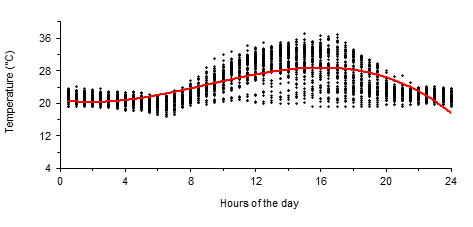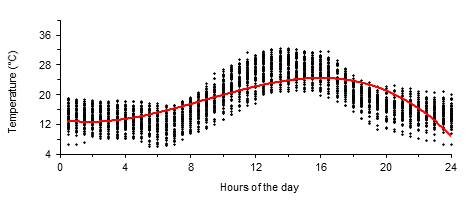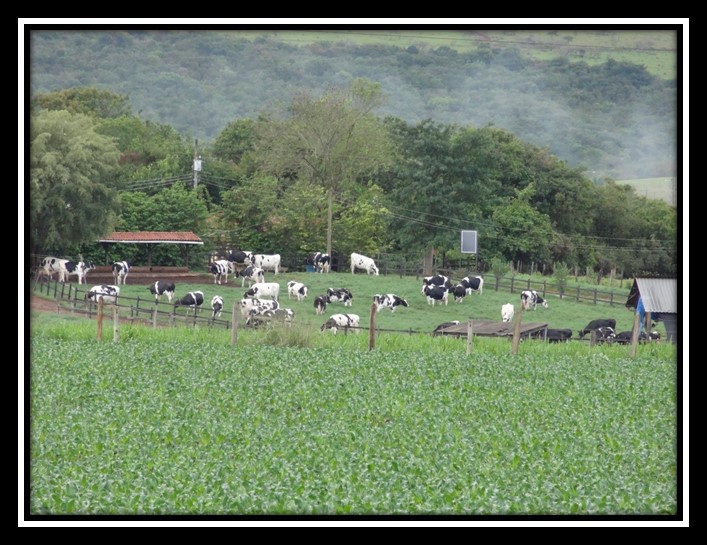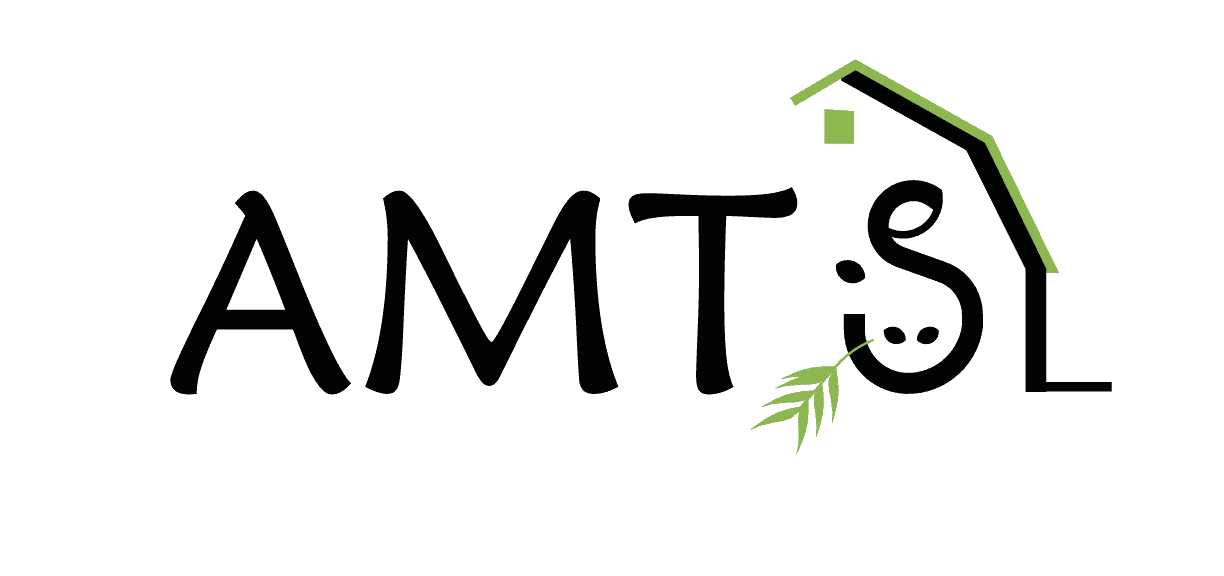Today we have the second part of the guest post by Dr. Marcos Neves Perira.
Part 2. Dairying in the south of Minas Gerais
The UFLA and the Better Nature Reaserch Center are located in the south of Minas Gerais. This hilly region is an important and traditional dairy and fine coffee producing area. The altitude varies from 800 to 1000m above sea level. During the summer (Rainy season) the temperature can be as high as 36oC inside a tie stall with fans and high pressure sprinkles (Figure 1), and as low as 5oC during the winter (Dry season) (Figure 2). Figure 3 presents the % of daily time with THI above 68 along the days of two summers (red and orange lines) and one winter (green line). Heat stress during summer is a challenge faced by high producing herds, resulting in increased cow performance and reproductive efficiency during the dry months of the year. However, for low income, subsistence dairy farmers, milk yield per cow and per farm may increase during the summer months, as a result of increased forage availability and quality. This may overflow the marked of milk supply, decreasing milk price at the end of the year, when concentrate prices simultaneously reach their maximum. The pasture based summer milk in the central latitude of Brazil may determine farm milk price in the whole country. Concentrating calvings planned to happen at the beginning of the winter months (April to May) is a strategy used by some farmers to deal with the inconsistency of the market and the summer heat, in order to obtain increased yearly productivity and profitability.
Figure 1.

Figure 2.

Figure 3.

The south of Minas Gerais has historically supplied milk to the high income São Paulo city population. Milk price in this region used to be higher than in other regions of the state, resulting in the development of milk production systems based on Holsteins and high concentrate content diets. The south of the state is a nationally known dairy area, with a historical fame of producing high quality Holsteins. Coffee crops have been associated with dairying for years, since they do not compete for labor, equipment, land, and time of the farmer. As the low lands of the region can occasionally suffer the occurrence of freezing rain during the winter, coffee has been cultivated only at the top of the hills, while low areas have been used for corn or pasture for more than a century. The harvesting of coffee also occurs during the dry season, while forages are produced during the rainy season. It has allowed for the same labor force and machinery to be used in both activities throughout the year. Coffee with milk is not only a drink, but an old agricultural combination in the south of Minas Gerais. The UFLA has strong scientific programs in coffee, corn (grain and silage), and dairy production, in accordance to the demand of the region.

The altitude and cool summer nights during summer favors the production of corn for silage, while the short period of daylight and the early cold during the dry season are not favorable to intensive tropical forage production, an explanation for the prevalence of dairy systems based on confined high producing cows in the south of the state. Corn for silage may be cultivated twice per year without irrigation, resulting in production of about 30 to 40 t of DM/ha, capable of feeding 6 to 9 Holsteins/ha/year on high corn silage content diets. Across the south border of Minas Gerais is the state of São Paulo, the major producer of oranges in the country. It made citrus pulp byproducts an important feed resource for dairying in south Minas Gerais. A nutritional challenge is providing physically effective fiber to diets based on high content of finely ground corn silage, usually done by small dietary inclusion of Tifton hay, usually an expensive source of long fiber. Dealing with flint endosperm type corn is another issue. Hydration simultaneously to ensilaging of mature finely ground corn grain has been widely adopted in recent years as a way of improving ruminal starch digestibility and cheaply storing the grain at the farm in a labor saving routine. The region is a major corn grain producing area, and this technology allows for the grain to be bought when price reaches its minimum, usually at the end of the summer harvesting season. Soybean meal is the major protein source and whole cottonseed is an important fiber and fat source, both imported into the region from the west.

Many small and large dairy companies are buyers of milk, what creates competition and tend to keep milk price slightly above the average Brazilian price. The south of Minas Gerais is considered a fine cheese production area, hosting the headquarters of Danone, for example. The São Paulo cooperative of dairy producers used to be an important buyer of milk in the region, but it has lost its power in the market, nowadays dominated by private dairy companies. As land price is relatively expensive, average farm size is not as large as in the west, making large scale beef operations absent in the region. Producing the maximum amount of milk per unit of area is necessary to be competitive financially.

We thank Marcos for the kindness of putting together this information. If you are reading this and would like to guest post about your region please contact me at mariann@agmodelsystems.com.
